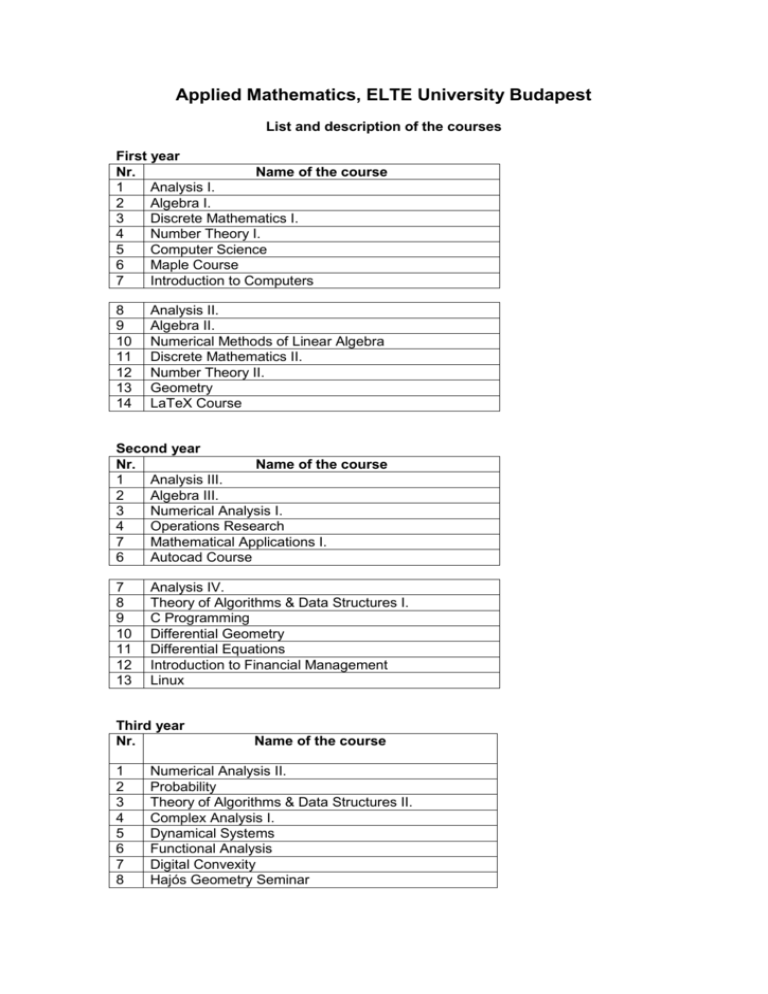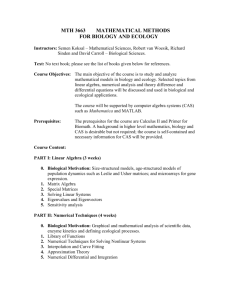International Masters Programme Vrije Universiteit Amsterdam
advertisement

Applied Mathematics, ELTE University Budapest List and description of the courses First year Nr. Name of the course 1 Analysis I. 2 Algebra I. 3 Discrete Mathematics I. 4 Number Theory I. 5 Computer Science 6 Maple Course 7 Introduction to Computers 8 9 10 11 12 13 14 Analysis II. Algebra II. Numerical Methods of Linear Algebra Discrete Mathematics II. Number Theory II. Geometry LaTeX Course Second year Nr. Name of the course 1 Analysis III. 2 Algebra III. 3 Numerical Analysis I. 4 Operations Research 7 Mathematical Applications I. 6 Autocad Course 7 8 9 10 11 12 13 Analysis IV. Theory of Algorithms & Data Structures I. C Programming Differential Geometry Differential Equations Introduction to Financial Management Linux Third year Nr. 1 2 3 4 5 6 7 8 Name of the course Numerical Analysis II. Probability Theory of Algorithms & Data Structures II. Complex Analysis I. Dynamical Systems Functional Analysis Digital Convexity Hajós Geometry Seminar third year, continuation 9 Stochastic Processes 10 Computational Complexity 11 Statistics 12 Fourier Analysis 13 Mathematical Logic 14 Applications of Probability and Statistics 15 Partial Differential Equations I. 16 Modelling River Pollution Fourth year Nr. Name of the course 1 Discrete Dynamical Systems 2 Continuous Dynamical Systems 3 Formulating Mathematical Models I. 4 Partial Differential Equations II. 5 Numerical Solution of Elliptic Equations 6 Computational Number Theory 7 Computer Algebra I. 8 Transformations Mathematics I. 9 10 11 12 13 14 15 16 17 Partial Differential Equations III. Special Functions Cryptography Computer Algebra Finite Element Method Formulating Mathematical Models Analysis of Mathematical Models Applications of Functional Analysis Transformations in Mathematics II. Short description of the courses First year 1. Analysis I-II. Sequences, convergence, Bolzano-Weierstrass, series, multiplication, convergence criteria, limit of mappings, continuity, open, closed and compact sets, differentiation, Darboux property, Taylor-formula, Riemann, Riemann-Stieltjes integration, functions of bounded variation, curves, function series, differentiation in higher dimension, inverse and implicit functions. 2. Algebra I-II. Complex numbers, (symmetric) polynomials, linear algebra, vector spaces, eigenvectors, Jordan, Cayley-Hamilton. Bilinearity, quadratic forms, Gram-Schmidt, Sylvester, Euclidean spaces and linear transformations, groups, free group, Dyck, Jordan-Hölder, solvable groups, direct product, finite Abelian groups, rings, number theory in rings, Euclidean rings. 3. Discrete Maths I.-II. Elementary algorithms, Dijsktra, graphs, Hall condition, Ramsey, König lemma, convex polygons, extremal problems, Turán, graphs in the plane, sieve method, Stirling numbers, normal and perfect graphs, Menger. 4. Number Theory I-II. Primes, congruences, congruence systems, Diophantine equations, Pythagorean triplets, Gauss integers, reduction of Fermat’s Conjecture.Thue, Waring problem. Diophantine approximation theory, Liouville, exponential sums. 5. Computer Science Unix, Maple. 7. Maple Course 8. Introduction to Computers Windows, Office, Internet 10. Numerical Methods of Linear Algebra Implementation of numbers in computers, matrix decompositions (LU, Cholesky, QR, singular, Schur), Gauss’ Algorithm, norms, errors of solution of linear equation, generalized solution, iterative methods, relaxations. 13. Geometry Affin and projective geometry Second year 1. Analysis III-IV. Jordan measure, integration, transformation of integrals, Fubini, Gauss-Green, primitive, Green-formulae, Poisson kernel, harmonic functions. Abstract measure theory, extension, Lebesgue-Stieltjes measures, Jordan, Hahn, Radon-Nikodym, differentiation of measures, interval functions, density. Lp spaces, convolution. 2. Algebra III. Commutative fields, extensions, Galois Theory, applications. Hamming and BCH codes. Lattices, Jordan-Dedekind, Kurosh-Ore. Noether rings. Ideal theory, radicals, Lasker-Noether, Dedekind rings. 3. Numerical Analysis Direct and iterative methods for calculating eigenvectors and eigenvalues. Interpolations, Chebyshev, Hermite. Uniform approximation. Splines, orthogonal polynomials 4. Operations Research Linear algebra, polyhedra, cones, Caratheodory, Farkas lemma, duality, polar cones, unimodular matrices, integer programming, simplex algorithm, currents, MFMC, Edmonds-Karp, Hungarian method, shortest walks, applications in geometry: Helly, Kirchberger, applications in the theory of games 6. Autocad Course Brief introduction to Autocad 7. Applications I. Introduction to Corporational Economy. Mathematics of Elections. 8. Theory of Algorithms & Data Structures I-II. Exercise, P and NP class, program verification, ADT & ADS, sorting (bubble, pan, radix, Batcher, tournament, heap, quicksort, shell, run), priority sequence, lists, stacks, sequences. Seeking. Coding. B-trees. Simultaneous min and max search.Median search, pattern fitting, Rabin-Karp, Knuth-Morris-Pratt. 9. C Programming ANSI C with standard libraries 10. Differential Geometry Curves, Lagrange, curvature, torsion, supporting trihedron, Serret-Fernet. Surfaces, first and second-order Gauss’ main curvature values, equivalence, classification, normal intersection, Meusnier, Euler, main directions, median curve. 11. Differential Equations Gronwall lemma, existence and unicity theorems, differentiable dependence, linear differential equations, solution, dynamical systems, stability, Ljapunoff, Barbasin-Krasovski, asymptotic behaviour, Poincaré-Bendixson, Floquet theory, HartmanGrobman,boundary problems, Sturm separation theorems, calculus of variation. 12. Introduction to Financial Management Treynor-Balck, CAP-M, bond pricing, options. 13. Linux Introduction to Linux from the viewpoint of a user and single-machine-administrator. Third year 1. Numerical Analysis II. Numerical integration, Simpson, Newton-Cotes, Gauss. Numerical solution of differential equations, higher order methods, Runge-Kutta, Taylor, Euler, Mylne-Simpson. Local and global error, 0-stability, A-stability. 2. Probability General random variables, and their functions (cdf, pdf, expected value, deviation, correlation, covariance etc.) independence, Kolmogoroff’s 0-1 law, stochastic, Lp convergence, metrics, Levy’s inequality weak convergence, Cramer-Sluckij, Prohoroff, Doob lemma, central limit theorems, Laws of Large Numbers (Khinchine, Bernstein, Kolmogoroff), Characteristic functions, Central Limit, inversion, Lindeberg-Feller, Ljapunoff, conditional expectation, convergence theorems, Jensen, martingales, Doob, Kolmogoroff, regular martingale, Kronecker lemma. 4. Functional Analysis Hilbert spaces, bounded operators, compact operators, Banach spaces, open mapping, closed mapping, Hahn-Banach, Banach-Steinhaus. 5. Dynamical Systems Equivalences, bifurcations, classification of linear systems. Smale. Special attractors. 6. Complex Analysis Holomorphic functions, Cauchy formulae, Laurent series, isolated singularities, residues, Rouche, Schwartz, etc., Weierstrass, conformal mappings, Hurwitz, Riemann mapping theorem, analytic continuation, Schwartz-Christoffel, Mittag-Leffler, Picard, Borel. Entire functions of finite order, harmonic functions. 7. Digital Convexity Affin and lattice geometry. Polyhedra, polytops, cones, separability. Carathedory, Radon, Helly, Gale in affin spaces. Pick, Chevtál-Frisk, Minkowski, Blichfelt, Voronoi, Caratheodory, Helly, Hermite constant, Rogers on lattices. 8. Hajós Geometry seminar Various lectures from Geometry. 9. Stochastic Processes Finite-state Markoff processes. Classification of states, recurrence, positive states, the limit of transition probability, stationary disribution. Poisson processes. Recovery processes, recovery function, recovery equation. Elementary recovery theorem, asymptotics of number of recoveries. Wiener processes, its constructionInvariance (Donsker). Characteristics of trajectories (nondifferentiability, quadratic variance, Hölder continuity). Kolmogoroff’s continuity and its application. 10. Computational Complexity Finite-state automata, regular languages, non-deterministic automata,Turing machines, recursive and recursively enumerable languages, recursive functions, universality,Rice. Time and memory complexity, polynomial algorithms, Cook, NP-complete problems (SAT, 3-SAT, 3-colouring, set partition, travelling salesman) 11. Statistics Estimations of the distribution function and the density, sufficiency, Fisher information, completeness, exponential families, point estimation, unbiasedness, admissibility, minimaxity, efficiency, blackwellization, information inequality. Asymptotic properties of estimators, consistency. Empirical estimators, method of moments, maximum likelihood estimation. Bayes estimation, sampling from finite population. Hypothesis testing, Neyman-Pearson lemma. One-sided and two-sided alternatives in exponential families, classical parametric tests and their optimality, likelihood ratio test, confidence sets and intervals, parameter estimation for the multivariate normal distribution, normal linear model. 12. Fourier Analysis topological groups, Haar-measure, character and dual of a group, Fourier transformations (TFT, TFC, TFS, DFT), elementary characteristics, unit approximation, wavelet operator, inversion, L2, Plancherel, differentiation, convergence, FT in AC, summations ((C,1), De La Vallé Poussin, Riesz, Rogosinski, Weierstrass, Abel, θ, Fejér, Poisson), consistency, Jackson polynomials. Approximations, Stone-Weierstrass, Jackson. 13. Mathematical Logic Russel paradoxon, cardinality, Cantor-Bernstein-Schröder, Cantor power set, continuum hypothesis, Brouwer-Sperner, computabililty, recursive functions, Church, primitive functions, logical operations, zero and first-order languages, formulae, Gödel incompleteness. 15. Partial differential equations Examples from Physics, classification of linear, second order PDE with constant coefficients, test functions, distributions, smooth functions, differentiation of distributions, direct product, convolution, fundamental solutions, classical and generalized Cauchy problem in the parabolic case, Green-formulae. Soboljev spaces, embedding to L2. Classical and generalized eigenvector problem, Fourier method. Fourth year 1. Discrete Dynamical Systems Topological transitivity, minimality. Symbolic dynamics, Bernoulli shift. Revolting the unit circle. General revolting number. Invariant measure, Riesz representation, Kryloff-Bogoluboff. Cantor and ω-limit sets, uniquely ergodynamicality and minimality, Haarmeasure, irrationally revolting maps are uniquely ergodynamical. Unimodality, ω-limit periodicity, ordering and weak equivalence, topological conjugatedness. Entropy, monotonicity, entropy of power map, equivalent definitions, zig-zag number, Misiuvewicz-Szlenk, Milnor-Thurston. Markoff graphs, Sharkovskii. 2. Continuous Dynamical Systems Manifolds. General Stabil Manifold Theorem. General Centre Manifold Theorem. General Hartman-Grobman Theorem. Hamiltonian Systems. 3. Formulating Mathematical Models I-II. Sample models of population and evolution dynamics. Transport processes. Models of marketing. 4. Partial Differential Equations II-III. Temperated distributions. General and partial Fourier transformation. Inversion, transformation of distributions with compact support. L 1&L2. Paley-Wiener. Application. Locally rectangular-like surfaces, trace operator, surfacial integral, embedding theorem, compactivity. More general elliptic equations, ellipticity, uniform ellipticity. Eigenvalue and boundary value problem. Variational analysis. Ritz, Galerkin methods. More general hyperbolic equation, unicity, Fourier method, Galerkin method. More general parabolic equations, unicity, Fourier method, Galerkin method. Non-linear equations, the abstract problem, Galerkin method. Bounded, finite dimensional, coercive, monotonic, pseudo-monotonic operators from reflexive, separable Banach spaces to its dual. Wk,p as special cases. 5. Numerical Solution of Elliptic Equations Comparison of methods. Differential schemes, stability, convergence, consistency, Lax. Comparison of solution methods for linear systems, preconditioning. Multigrid methods, interpolations, relaxations, smoothing possibilities. 2 nd –order boundary condition approximation. Convergence. Friedrichs, 1D example, FFT, eigenvalues. General domain, Hilbert-Schmidt core. 6. Computational Number Theory Time of elementary operations. Erathostenes’ sieve, calculating gcd. Congruencies, calculating multiplicative inverse, solving linear system of congruences. RSA, modular power. Factorization, Mersenne primes. Finite fields, nth unit roots in F q. Quadratic residues, Jacobi symbol, calculating Legendre symbol. Evolving radicals mod p. Error correcting codes. Cryptography, discrete logarithm, Diffie-Hellman. Deterministic and stochastic prime test, pseudo primes, Carmichel numbers, Solovay-Strassen. Fermat factorization, factor base, quadratic sieve. Elliptic curves, over finite fields, Hasse, Diffie-Hellman. 7. Computer Algebra I-II. Orderings of polynomials, Dickson, Hilbert, Gröbner base, Buchberger. P-adic numbers, Ostrakowski, Hensel. Primes, factorizations, long multiplication. Resultant, discriminant, supporting matrix, measure, reducibility, square-free factorization, Berlekamp, Kronecker. Symbolic integration, differential fields, logarithmic extension, Hermite, Horowitz, Rothstein-Tragen. 8. Transformations in Mathematics I-II. Bessel’s Inequality, Riemann-Lebesgue Lemma, Fejér. Calculating area, curvature, arclength, moments, centre of mass with Fourier coefficients. Parametrization, symmetries. Two-terms. Fourier series of piecewise linear paths, special cases. DFT. Corresponding algorithms. Contouring. Zak transformation, L2, surjectivity, convolution. Bases, biorthogonality. Frames, reconstruction, Weyl-Heisenberg. Gábor and Wavelet transformations. Voice transformation, Haar-measure, Heisenberg group. Peter-Weyl. Disc algebra. Rademacher, Kolmogoroff. Riesz base. 9. Special Functions Γ, ζ, Bessel, spherical functions 10. Cryptography Classic codings (transposition, substitution, block and polyalphabetic versions), breaking. DES, AES.Entropy. Public key coding, RSA, Rabin. 11. Finite Element Method Comparison. 1D example. Realization, choice of the base, Nitsche, Aubin, Oganesjan-Ruhovec). Multivariate case, hp methods, implementation.






